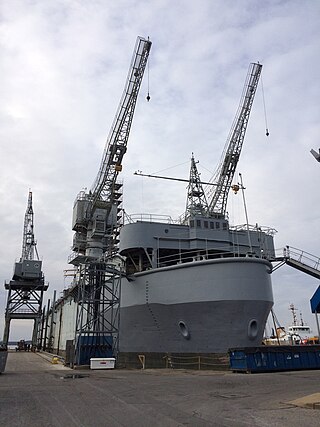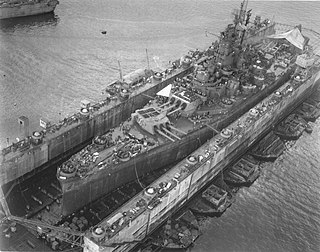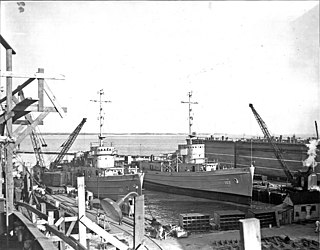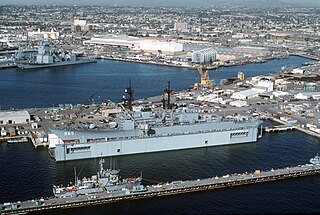
USS Oak Ridge (ARD-19/ARDM-1) was originally a United States Navy Auxiliary floating drydock suitable for dry docking destroyers, submarines and landing craft, built by the Pacific Bridge Company. In the early 1960s she was upgraded to support Los Angeles-class submarines, and re-classified as ARDM-1-class. A stern door and enclosed bow design allows for open ocean transits. The dock is non-propelled and therefore must be taken under tow to operational areas of the fleet. A steering mechanism with twin rudders is installed to facilitate this operation. Sufficient electrical power was provided by four diesel-driven generator sets to maintain all normal and operational requirements. Living, berthing, and mess facilities are provided for the dock's complement of 5 officers, 10 CPO's and a crew of 186.

USS Alsea (AT-97) was an Abnaki-class of fleet ocean tug. It was named after the Alsea Native American tribe in Oregon.

USS Artisan (ABSD-1), later redesignated as (AFDB-1), was a ten-section, non-self-propelled, large auxiliary floating drydock of the United States Navy. The only U.S. warship with this name, Artisan was constructed in sections during 1942 and 1943 by the Everett-Pacific Shipbuilding & Dry Dock Company, in Everett, Washington; the Chicago Bridge & Iron Company, in Eureka, California; the Pollock-Stockton Shipbuilding Company, in Stockton, California; and the Chicago Bridge & Iron Company, in Morgan City, Louisiana. This ship was commissioned at Everett, Washington, on 10 May 1943, Captain Andrew R. Mack in command. With all ten sections joined, she was 927 feet long, 28 feet tall, and with an inside clear width of 133 feet 7 inches.

USS Dewey (YFD-1) was a floating dry dock built for the United States Navy in 1905, and named for American Admiral George Dewey. The auxiliary floating drydock was towed to her station in the Philippines in 1906 and remained there until scuttled by American forces in 1942, to prevent her falling into the hands of the invading Japanese.

USS Richland (YFD-64/AFDM-8) was an AFDM-3-class medium auxiliary floating drydock built in California for the U.S. Navy. Originally named USS YFD-64, she was towed to the Philippines and Guam where she served until war's end.

USS Adept (AFD-23) was a AFDL-1-class small auxiliary dry dock of the United States Navy Auxiliary floating drydock built for World War II.

USS Chimariko (ATF-154) was an Abnaki class Fleet Ocean Tug of the United States Navy and the first to be named Chimariko after the Native American tribe in California.

An auxiliary floating drydock is a type of US Navy auxiliary floating dry dock. Floating dry docks are able to submerge underwater and to be placed under a ship in need of repair below the water line. Water is then pumped out of the floating dry dock, raising the ship out of the water. The ship becomes blocked on the deck of the floating dry dock for repair. Most floating dry docks have no engine and are towed by tugboats to their destinations. Floating dry docks come in different sizes to accommodate varying ship sizes, while large floating dry docks come in sections and can be combined to increase their size and lift power. Ballast pontoon tanks are flooded with water to submerge or pumped dry to raise the ship.

USS AFDM-2,, is an AFDM-3-class medium auxiliary floating drydock built in Mobile, Alabama by the Alabama Drydock and Shipbuilding Company for the U.S. Navy. Originally named USS YFD-4, Yard Floating Dock-4, she operated by Todd Shipyards at New Orleans, Louisiana for the repair of US ships during World War II. YFD-4 was renamed an Auxiliary Floating Dock Medium AFDM-2 in 1945 after the war.

ABSD-6 is an advanced base sectional dock which was constructed of nine advance base docks (ABD) sections for the US Navy as an auxiliary floating drydock for World War II. ABSD-6 was built by Mare Island Naval Shipyard at Vallejo, California. ABSD-6 was commissioned on 28 September 1944. Advance Base Sectional Dock-6 was constructed in sections during 1942 and 1943. Each section are 3,850 tons and are 93 feet long each. Each Section had a 165 feet beam, a 75 feet molded depth and had 10,000 tons lifting capacity each. There were 4 ballast compartments in each section. With all nine sections joined, she was 825 feet long, 28 feet tall, and with an inside clear width of 133 feet 7 inches. ABSD-2 had a traveling 15-ton capacity crane with an 85-foot radius and two or more support barges. The two side walls were folded down under tow to reduce wind resistance and lower the center of gravity. ABSD-6 had 6 capstans for pulling, each rated at 24,000 lbf (110,000 N) at 30 ft/min (0.15 m/s), 4 of the capstans were reversible.
Everett-Pacific Shipbuilding & Dry Dock Company was established in 1942 to build ships needed for World War II. Yard construction began on 1 March 1942. As part of the Emergency Shipbuilding Program the US Navy provided some of the capital to start Everett-Pacific Shipbuilding at Port Gardner Bay in Everett, Washington. Everett-Pacific was sold in 1945 to the Pacific Car and Foundry, who was already a major manufacturer of railcars and trucks. Pacific Car and Foundry was building barges for the US Navy during World War II at plants in Renton, Seattle and Tacoma in the state of Washington. The lease for the shipyard in Everett, Washington ended in 1949 and the yard closed. Pacific Car and Foundry in 1972 changed its name to Paccar Inc. to reflect its major products. The Everett-Pacific shipyard site later became part of Western Gear, a heavy machinery manufacturer. in 1987 the shipyard became part of Naval Station Everett. Everett-Pacific Shipbuilding was started by William Pigott Jr. a Seattle businessmen and his brother Paul Pigott (1900-1961). William Pigott Jr. was born in 26 Aug. 1895 in Pueblo, CO and died on 8 July 1947 in San Francisco, CA.
Pollock-Stockton Shipbuilding Company was established in 1942 to build ships needed for World War II. As part of the Emergency Shipbuilding Program the US Navy provided some of the capital to start Pollock-Stockton Shipbuilding at Stockton, California. The shipyard was located at San Joaquin River and Stockton Channel, near Louis Park. After the war the shipyard closed down in February 1946.

Naval Advance Base Espiritu Santo or Naval Base Espiritu Santo, most often just called Espiritu Santo, was a major advance Naval base that the U.S. Navy Seabees built during World War II to support the Allied effort in the Pacific. The base was located on the island of Espiritu Santo in the New Hebrides, now Vanuatu, in the South Pacific. The base also supported the U.S. Army and Army Air Corps, U.S. Coast Guard, and US Marine Corps. It was the first large advance base built in the Pacific. By the end of the war it had become the second-largest base in the theater. To keep ships tactically available there was a demand for bases that could repair and resupply the fleet at advance locations, rather than return them to the United States. Prior to December 7th, Pearl Harbor was the U.S. fleet's largest advance base in the Pacific. Espiritu became capable of all aspects necessary to support the Fleet's operations from fleet logistics in fuel, food, and ammunition, to transport embarkation for combat operations or returning to the continental United States. The ship repair facilities and drydocks were capable of attending to most damage and routine maintenance. Had it not existed, ships would have had to return to Pearl Harbor, Brisbane, or Sydney for major repairs and resupply. The base became a major R and R destination for the fleet.

USS Hidatsa (ATF-102) was Abnaki-class tugboat during the World War II. The ship was later sold to Colombia as ARC Rodrigo de Bastidas (RM-74). Her namesake is an Indian group of the Sioux Tribe of North Dakota, now living on the Fort Berthold Reservation.

USS AFDM-3,, was the lead ship of the AFDM-3-class floating dry dock built in 1943 and operated by the United States Navy.

USS Competent (AFDM-6),, was an AFDM-3-class floating dry dock built in 1943 and operated by the United States Navy.

The USS Sustain (AFDM-7),, was a AFDM-3-class floating dry dock built in 1945 and operated by the United States Navy.

USS Resolute (AFDM-10),, was a AFDM-3-class floating dry dock built in 1945 and operated by the United States Navy.

USS Steadfast (AFDM-14) is a AFDM-14-class floating dry dock built in 1945 and operated by the United States Navy.

USS LST-399 was an LST-1-class tank landing ship in the United States Navy during World War II.
















